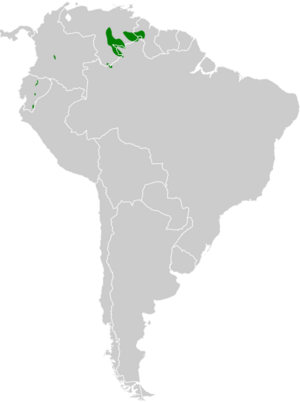Plain-winged antwren facts for kids
Quick facts for kids Plain-winged antwren |
|
|---|---|
| Conservation status | |
| Scientific classification | |
| Genus: |
Myrmotherula
|
| Species: |
behni
|
 |
|
The plain-winged antwren (Myrmotherula behni) is a small bird that belongs to a group called "typical antbirds". It lives in the forests of South America. You can find this bird in countries like Brazil, Colombia, Ecuador, Guyana, Venezuela, and possibly Suriname.
Contents
About the Plain-Winged Antwren
What's in a Name?
The plain-winged antwren has a scientific name, Myrmotherula behni. The "behni" part of its name honors a person named Wilhelm Friedrich Georg Behn. Scientists often name new species after people who helped with their discovery or study.
Different Types of Plain-Winged Antwrens
Just like there can be different types of dogs (like poodles and retrievers), there are different types of plain-winged antwrens. These are called subspecies. They are slightly different depending on where they live. There are four known subspecies:
- M. b. behni
- M. b. yavii
- M. b. inornata
- M. b. camanii
Scientists think the plain-winged antwren is closely related to a few other antwren species. These include the Alagoas antwren, the unicolored antwren, and the Yungas antwren. They all sound similar and like to live in similar places.
What Does It Look Like?
The plain-winged antwren is a small bird, about 9 to 9.5 centimeters (around 3.5 to 3.7 inches) long. It has a short tail.
Males
Adult male plain-winged antwrens are mostly gray. Their upper parts are a bit darker gray than their belly. They have a black patch on their chin, throat, and upper chest.
Females
Adult female plain-winged antwrens look a bit different. Their upper parts are brownish-olive, with a grayish color on their head and neck. Their tail and wings are also brownish-olive. Their throat is whitish, and the rest of their belly is olive-buff.
Subspecies Differences
The different subspecies have slight variations in color:
- Males of M. b. yavii are darker than the main type. Females have darker olive-buff sides.
- Males of M. b. camanii are somewhere in between the main type and yavii in color.
- M. b. inornata is a bit larger. Males have a darker and wider black area on their throat. Females have reddish-brown upper parts.
Where Do They Live?
The plain-winged antwren lives in different, separate areas across South America. This is called a "disjunct distribution."
Specific Locations
- M. b. behni: Found in south-central Colombia and in parts of eastern Ecuador.
- M. b. yavii: Lives in northwestern Venezuela and also in a separate area in Venezuela's Amazonas state, reaching into northern Brazil.
- M. b. inornata: Found in southeastern Venezuela, northern Brazil, and the Pacaraima Mountains in Guyana. There are also possible sightings in Suriname.
- M. b. camanii: Lives on a mountain called Cerro Camani in Venezuela.
Their Home Environment
These birds like to live in the lower and middle parts of evergreen forests, especially in foothills and lower mountains. In Ecuador, they seem to prefer damp areas with bamboo plants. In Venezuela and Brazil, they are found at elevations between 1,000 and 1,850 meters (about 3,280 to 6,070 feet). In Colombia, they live between 1,200 and 1,800 meters (about 3,940 to 5,900 feet). In Ecuador, they are mostly found between 800 and 1,600 meters (about 2,620 to 5,250 feet).
Behavior and Habits
Movement
The plain-winged antwren is thought to stay in the same area all year round. It does not migrate to different places.
Feeding Habits
Scientists don't know exactly what the plain-winged antwren eats in detail. However, they believe it mostly eats insects and spiders. This bird usually forages alone, in pairs, or in small family groups. It almost always joins up with other types of birds to form a "mixed-species feeding flock." This means different bird species hunt for food together.
The antwren usually looks for food about 1 to 3 meters (3 to 10 feet) above the ground where the forest is thick. In more open areas, it might go higher, between 4 and 10 meters (13 to 33 feet). It actively searches for prey, especially among dead leaves. It also finds food on live leaves, stems, and branches. It catches its food by reaching, hanging, lunging, or sometimes by fluttering out from a branch.
Reproduction and Life Cycle
Not much is known about how the plain-winged antwren reproduces or its breeding habits. Scientists are still learning about this part of its life.
Vocalization
The plain-winged antwren's song is a series of high, simple notes that sound a bit like "tiuw." Its calls include a sharp "sweeík" and a more nasal "kyunh."
Conservation Status
The IUCN (International Union for Conservation of Nature) has listed the plain-winged antwren as a species of "Least Concern." This means that, for now, it is not considered to be in danger of extinction.
Even though it has a large range, scientists don't know how many plain-winged antwrens there are. They believe the population might be decreasing. No immediate threats have been found for this bird. It is considered rare and local in the places where it lives. It can be found in some protected areas. More research is needed to understand where these birds live, how they live, and what they need to stay safe.


